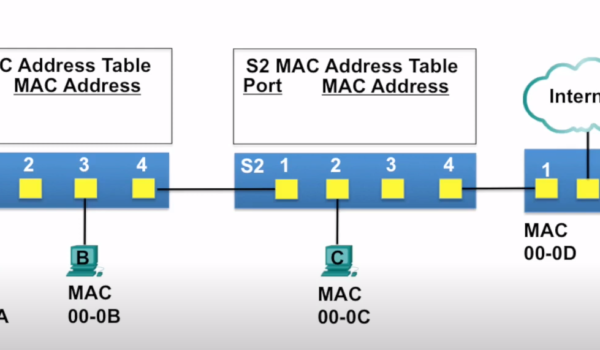In the dynamic realm of computer networking, the seamless exchange of data takes center stage, orchestrating harmonious communication among various devices. An indispensable element, wielding substantial influence over this intricate interplay, is the MAC address table. Embarking on a journey through this article, we shall navigate the depths of MAC address tables, unearthing their profound significance, deciphering their operational mechanics, and unraveling commonplace queries. By embarking on this quest, we aim to cultivate a heightened grasp of this pivotal networking paradigm.
What is a MAC Address Table?
Encompassed within network switches, a MAC (Media Access Control) address table, alternatively recognized as a MAC address forwarding table or MAC address filtering table, emerges as a cornerstone component. It embodies a dynamic repository that aids switches in deciphering the optimal route for dispatching data frames toward their intended destinations. At its core, the MAC address table assumes the role of a conductor, orchestrating the symphony of network performance enhancement by skillfully regulating the fluid transmission of data amongst diverse devices.
Key Points:
- MAC address table is a dynamic database within network switches;
- It assists switches in directing data frames to their designated destinations;
- Skillfully oversees the data flow between devices to enhance network performance.
How Does a MAC Address Table Work?
Upon the arrival of a data frame at a network switch, a meticulous sequence unfolds. The switch initiates its examination by scrutinizing the source MAC address encapsulated within the frame. Subsequently, an entry is meticulously appended to the MAC address table, forging a connection between the source MAC address and the very port that ushered the frame into the switch’s domain. This ingenious maneuver empowers the switch with the ability to etch the device’s network locale into memory.
Proceeding with purpose, the switch’s gaze then rests upon the destination MAC address dwelling within the data frame. A moment of reflection takes place as the switch refers to the MAC address table, seeking a fragment of knowledge regarding the destination’s existence. Upon the discovery of an entry in its records, the switch takes on the role of courier, deftly steering the data frame towards its rightful egress, a port elegantly etched within the table’s confines. In contrast, when the absence of an entry marks the switch’s perception, a captivating dance unfolds. Known as flooding, the switch orchestrates the broadcast of the data frame across myriad ports, sparing only the source port from this vivacious cascade.
Key Points:
- Switches add entries to the MAC address table based on source MAC addresses;
- The table associates MAC addresses with specific ports;
- Switches use the table to forward data frames efficiently;
- If no entry is found, the switch floods the data frame to all ports except the source port.
Importance of MAC Address Tables
The relevance of MAC address tables lies in their pivotal role, enhancing the efficiency of networks while concurrently mitigating superfluous traffic. Absent these tables, switches would find themselves obligated to disseminate data frames universally, addressing all connected devices in the process. This unfortunate scenario would inevitably pave the way for network congestion and subsequently decelerated communication. However, with the strategic employment of MAC address tables, switches can astutely route data solely to its intended recipient, thus culminating in a marked reduction of unneeded traffic and a pronounced enhancement of the holistic network performance.
Key Points:
- MAC address tables enhance network efficiency;
- They prevent unnecessary traffic and network congestion;
- Improve overall network performance by directing data to the intended recipient.
Conclusion
Navigating the intricate realm of networking unveils the indispensability of MAC address tables, serving as crucial instruments for the seamless transmission of data. Through the judicious association of MAC addresses and specific ports, switches gain the acumen to adeptly channel data frames to their designated recipients. This orchestration mitigates superfluous traffic, thereby optimizing the performance of the network. Our explorations within this article have underscored the paramount nature of MAC address tables in fostering uninterrupted communication amongst devices within contemporary networks.
For a more vivid understanding illuminated through visual representation, I invite you to peruse an enlightening video elucidating the fundamentals of networking. By plunging deeper into this foundational concept of networking, you stand poised to augment your comprehension of how data meanders through intricate networks, consequently nurturing the evolution of more streamlined and efficacious communication systems.
FAQ
Certainly, MAC addresses serve as distinctive identifiers allocated to network interfaces by manufacturers, endowing them with a globally unparalleled identity. This inherent singularity is the cornerstone of assurance, guaranteeing that within a network, no two devices share an identical MAC address.
In the scenario where a switch encounters a data frame bearing an unfamiliar destination MAC address, its response involves disseminating the frame across all ports except the originating port. This phenomenon is recognized as “unknown unicast flooding.”
Indeed, from a technical standpoint, MAC addresses can undergo alteration or be manipulated through spoofing, a process demanding specialized expertise and tools. Nonetheless, it’s important to note that modifying MAC addresses is generally discouraged due to its potential to trigger connectivity problems within the network.
Routers predominantly function within the network layer (Layer 3) of the OSI model, leveraging IP addresses as the foundation for making routing determinations. While certain routers might possess MAC address tables serving particular roles such as facilitating the Address Resolution Protocol (ARP), their primary emphasis remains directed towards the realm of IP routing.
A MAC address constitutes a hardware-rooted identifier designated to a network interface, whereas an IP address assumes the role of a logical label attributed to devices existing within a network. Functionally, MAC addresses operate harmoniously within the data link layer (Layer 2), while IP addresses function within the confines of the network layer (Layer 3).
